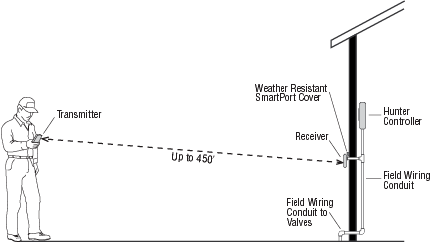Due to the rapid acceptance of the Hunter ROAM amongst Hunter Irrigation Products suppliers and end users, this Support Article is dedicated to the installation guidelines of our remote control kit.
Preparing the Communication Port
To utilize the ROAM and ICR Remote Control Systems, your controller must be equipped with a Smartport wiring harness, which provides the communication port where the ROAM and ICR receiver is attached. One wiring harness and installation instruction guide is provided with each ROAM and ICR kit. Additional wiring harnesses may be purchased separately to allow you to utilize the transmitter and receiver with additional Hunter controllers.
Connecting the Wiring Harness Kit
1. Install a 1/2"(12.7mm) female threaded "Tee" in the field wiring conduit approximately 12"(304.8mm) below the the Hunter controller.
Note: the harness may be installed outdoors by first bringing the conduit through an exterior wall, then installing the appropriate fitting.
2. Feed the red, white, and blue wires of the harness through the base of the "Tee" and into the controller wiring compartment.
3. Screw the harness housing into the "Tee" (or other fitting).
4. Attach the red, white, and blue wires from the harness to the terminal block of the controller.
5.The wiring harness' 1/2" male thread has a 90º ratcheting mechanism to allow the receiver to be set in a vertical position for the best reception.
Extending the Wiring Harness
Any extension of the wiring on the harness may result in an error message in the controller display and possible malfunction of the remote unit due to radio interference. In some situations, lengthening of the harness may work fine, in others it may not work at all (it is site specific). In either case, extending the wiring harness should be done using shielded cable to minimize the possible effects of electrical noise.
Proper Extension of Wiring Harness Using Shielded Cable

Maximizing Operating Range
There are many factors which influence operating range. Listed below are a few things you can do to assure you are getting the maximum range possible.
1. Do not install the outlet of the wiring harness (that the Receiver connects to) near large sources of metal such as power meters, water pipes, and aluminum siding.
2. Do not install the outlet of the wiring harness in a basement or underground location. The higher, the better.
3. For maximum range in all directions from the Receiver, the Receiver antenna should be pointed straight up (vertically). If the Receiver is mounted with its antenna oriented horizontally, reception will be very good if the Transmitter is on either side of the antenna, but very poor if it is facing the end of the Receiver antenna.
4. When operating the Transmitter, hold the Transmitter as vertical as possible and turn and face the direction of the Receiver, even if it is several hundred feet away.
Still need help? We're here.
Tell us what you need support with and we'll find the best solution for you.

